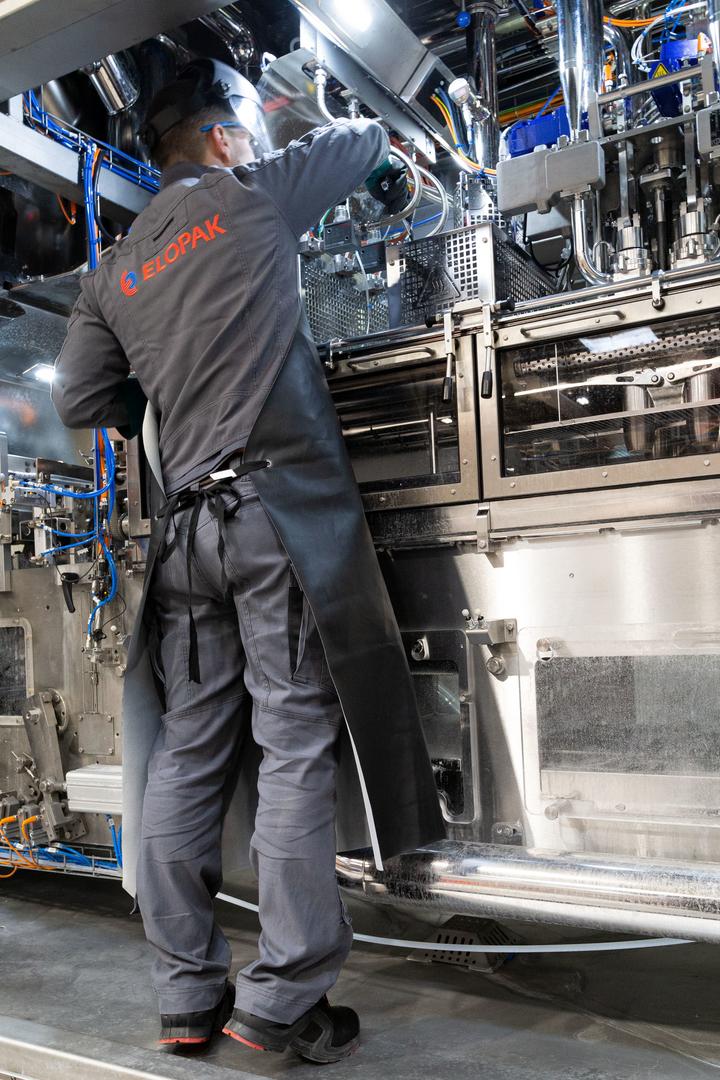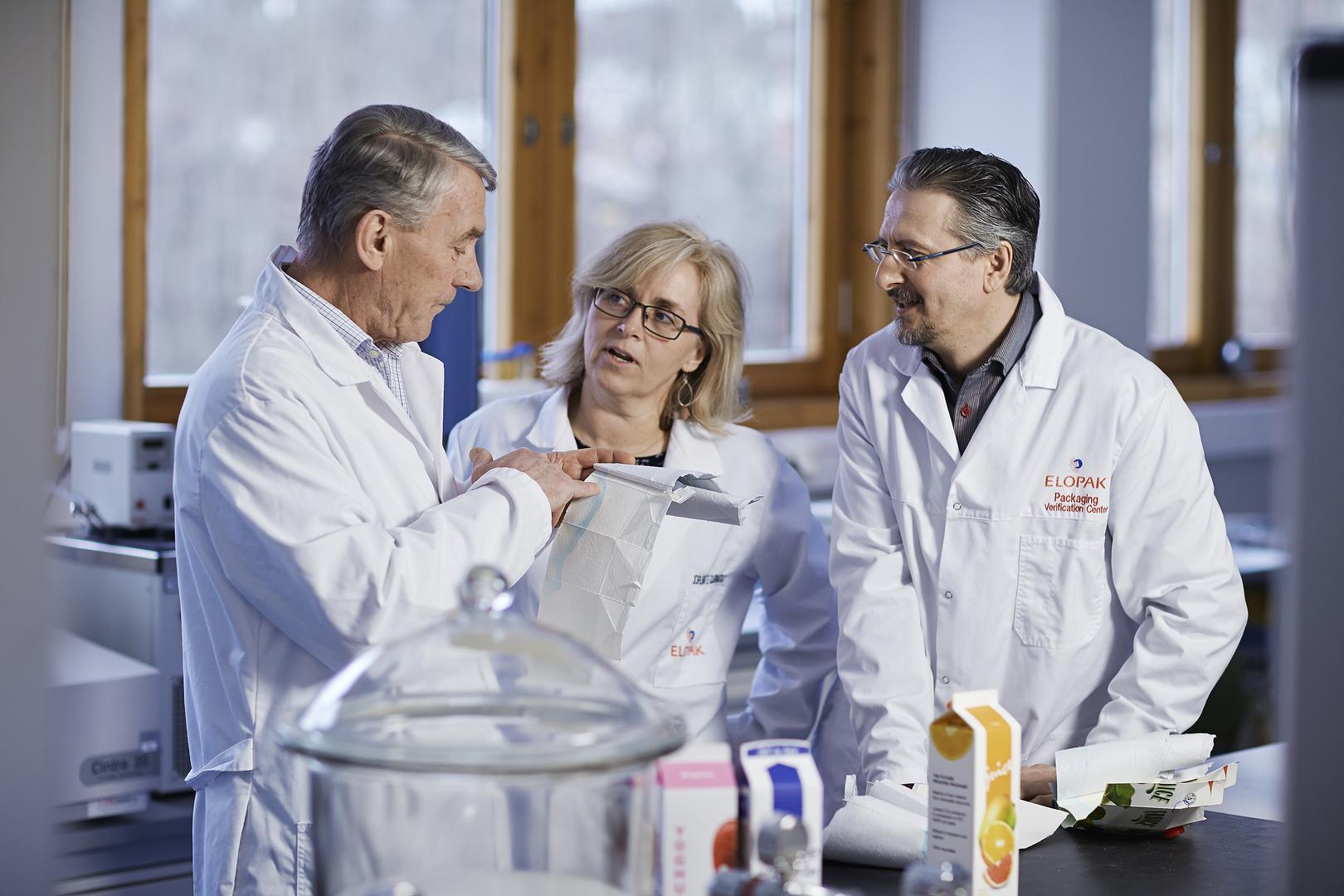Our Health and Safety
Elopak’s continued drive to improve safety in operational areas has resulted in a significant reduction in recordable injuries in comparison to 2019. Elopak has historically used the LTI rate as the high-level safety KPI, as is the norm in the industry. To bring more attention to all safety incidents, the focussed high-level KPI will be changed to Total Recordable Injury rate, TRI*.
The majority of production sites have already reached the long-term target of zero recordable injuries. At Group level a long-term plan and supportive strategy has been rolled out which provides the framework for safety plans. Therefore, to make Elopak an even safer workplace, key focus items have been implemented in all local safety plans, together with tailored initiatives. Technical safety remains on the agenda, together with several previous focus areas, but developing a culture of safety is increasingly important. A program has been initiated to enable leaders to better interact with the organization, to understand underlying factors, and to make sure safety issues are understood. This program will be brought further into local organizations during 2021.
* TRI Rate refers to Total Recordable Injury Rate, the number of recordable injuries occurring in a workplace per 1 million hours worked. A recordable injury is a separate, identifiable, unintended incident, which occurs as a direct result of work, which causes physical injury and for which a corrective action can normally be identified. This includes death, permanent disabilities, Lost Time Injuries, Restricted Work Case injuries and Medical Treatment Case injuries, all where treatment from a medical professional is required.
Occupational safety management system
Elopak commits to proactively ensure a safe workplace by including safety into all our daily processes and activities. Safety is a core value in Elopak. In fulfilling our commitment to protect our assets; people and property, Elopak provides and maintains a safe work environment in accordance with local legal requirements, company and industry standards and our Corporate Safety Policy. Our production units are either certified or performing self-assessments according to ISO 45001.
In Elopak we are committed to working with continuous improvement according to our Elovation program (Elovation is our framework for continuous improvement, implemented globally with local managers at all production sites). Continuous improvement also means to improve processes and standards – and to maintain equipment so to achieve zero accidents and injuries. To meet this commitment, we take all reasonable steps by striving continuously and systematically to improve our workplace, ways of working, employees’ training and skills. In order to identify, monitor and control safety performance Elopak sets and manages safety targets.
Safety at work is a management responsibility, ranking equally with responsibilities for Elopak’s commercial activities. However, every Elopak employee has an individual and collectively responsibility for safety at work. Each production plant and unit has its own Safety Officer to support our safety programs as well as to monitor and secure compliance.
The following mechanisms are in place to drive safety performance:
Management processes
Elopak performs an annual internal safety audit evaluation of compliance and achievements including:
- Policy, strategy, targets
- Common focus items
- Safety standard
There are monthly reports of activities including leading and lagging indicators to the Board of Directors, Global Leadership Team and the organization as applicable.
All our operational units are either certified or self-assessed in accordance to ISO 45001.
Any incidents are reported to top management for review.
Review of safety culture and performance with relevant Works Councils or similar groups.
Leading indicators to drive safety performance include:
- Quarterly safety network alignment across Elopak
- Quarterly safety plan review by Corporate Safety
- Safety Walks performed by all levels of management
- Safety observations
Hazard identification, risk assessment, and incident investigation
A good safety culture is needed to achieve our target of zero injuries, together with structured methods to identify and manage hazards and risks. For the latter, we have several tools in use. Hazard identification is performed by all employees, and for relevant hazards, they all act on and report. Such reports are measured as a leading KPI.
We have structured programs in place for risk assessments, both for physical areas, machines, and for tasks. For non-routine work we use Last-Minute Risk Assessment to identify and manage risks before any action is started.
Our local Safety Officers work together with their teams to make sure the relevant programs are being followed, and that the desired effects are achieved. Findings are managed by a Plan-Do-Check-Act cycle to ensure that we are gaining the right learnings and taking the correct actions.
Reporting is currently arranged by local systems. Although the expectation that all employees should act on dangerous situations is anchored in our governing documents such as the Code of Conduct and Safety Policy, we also accept anonymous reports. Safety is a number one priority in Elopak, and we expect everyone to take any needed action to remain safe at work. Interfering with production to remain safe is fully accepted if that is what it takes to work safely.
We still experience safety incidents in Elopak, and when they happen, there are dedicated processes defined for their management. Immediate countermeasures are arranged locally. Any fatality or recordable injury is reported to the Corporate organization. A review of the incident is arranged with the relevant Business Area Vice President, the responsible manager(s) and the local Safety Officer. This review is initiated by the Corporate Safety Director and the Corporate Senior Manager for safety. The intention with such reviews is to align on what has happened and the initial actions. Often a set of additional actions is agreed to ensure that the same incident will not take place again. A Safety Alert is defined with key learnings and actions, to inform the rest of the organization. Although such incidents are not wanted, we realize that they have significant value for driving safety culture through dialogue and learnings.


Occupational health services
Absence due to sickness has been reduced from 4,1% in 2019 to 3,9% in 2020 in the Elopak Group. Corrective actions with focus on health and safety activities for managing a healthy and proper business environment are carried out in cooperation between the HR/HSE organization, relevant line managers and local health service providers. When relevant, employees are invited to perform alternative tasks or to work part-time as part of a program to get back to work earlier.
Yearly health checks, especially related to exposed groups like operators in the plants and Field Service Engineers, are normally carried out frequently, but have of course been challenging to uphold during the Covid-19 pandemic.
External health service providers also assist our sites with regards to guidance for the employees.
Other activities include annual programs in special projects, for instance staying fit, healthy food advices etc. Team leaders are also trained in people management processes for effective and friendly communication with regards to well-being and sick leave follow-up.

Worker participation, consultation, and communication on occupational health and safety
Corporate Management maintains a close dialogue with the European Works Council with regards to the working environment. The members are frequently updated with regards to business updates, organizational changes that affect more countries and other relevant topics. Local Management keeps corresponding dialogue with local Works Councils with regards to the local work environment, health, safety and preventive actions.
Employee training on occupational health and safety
As competencies are key in order to understand where there are risks and how to deal with risks, specific training is needed. Tailored training programs are used for this purpose – general training for everyone, and detailed training for special areas and activities. Learnings from every recordable injury are shared across Elopak and get integrated in trainings as applicable. Competent employees or external experts are providing trainings, and training effectiveness is measured by tests where needed, as a certain level of competences are required before special tasks can be started. Certificates are required for certain tasks. Trainings are arranged during regular working hours.
Taking care of people during challenging times
Elopak takes employee health seriously and facilitates local access to health services at our largest sites. The Covid-19 pandemic changed the working life for our employees dramatically.
Workers in manufacturing plants, test centers and laboratories a had to take on many extra precautions to maintain health and safety during production and work processes. Field service engineers met extreme challenges when travel restrictions made it almost impossible to reach customer facilities to assist and support customers production lines and projects.
All office staff was requested to work from home. This was a challenge for many employees as their homes were not equipped for office work. Creative solutions had to be found and Elopak supported employees by let them take office equipment home, provide extra pc screens and what else was needed to make working from home possible.
Several activity and motivation campaigns were initiated to keep employees active, motivated and taking care of their mental health. One of the campaigns encouraged employees to share pictures of their new working environment and workplaces. More than 150 employees send pictures of their workplaces at the kitchen table, living room, working outdoors or with their children surrounding them.
Guidelines with training and nutrition tips were issued frequently to all employees. Managers were frequently reminded to stay in contact with their teams paying special attention to signs of stress, depression and exhaustion.
The roll-out of the Teams application enabled employees to stay in contact easier and ‘see’ colleagues even though only on screens.
Mental health and safety were major topics through all of the Covid-19 pandemic. A survey at the end of the 2020 showed that employees felt that they were well taken care of, were well informed and trusted the company to make the right decision in these challenging times.

Keep employees moving
Local initiatives were also taken to enable employees to take care of their health and keep moving during Covid-19.
Norway
In Norway all employees have access to a fitness room at Corporate Offices. This was kept available for self-training of employees during most of the Covid-19 pandemic. Extra cleaning procedures and strict rules for use were put into place enabling employees to have a training possibility while public training facilities were closed.
In addition, a bi-weekly program to ‘stretch and bend your neck’ was offered performed by a professional trainer via Teams. This was a very welcome initiative and many employees participated. The training sessions were also made available via the local intranet and will continue during 2021.
Health and safety on business travels
Elopak’s employer liability spans from “door to door” also when employees are on business travels and safety is our number one concern. Elopak aims to protect employee health and safety when travelling while also making it possible for the company to operate in conflict areas and have therefore entered into a global agreement with Falck/SCR/AIG. The group wide travel insurance program includes travel assistance service world-wide 24/7. An App, Safeture – Elopak Travel Security App, with link to the web portal, keeps the employees informed on security, health and transportation issues wherever they are travelling or before a trip is carried out. The app has a direct call button to Falck and the employees will be directly directed to Falck in case of emergency.
Elopak strengthened the information to the employees during the Covid-19 pandemic for any need for local health assistance providers close to where they are staying if they get sick during their business travels.
Prevention and mitigation of occupational health and safety impacts directly linked by business relationships
Health and safety is managed by the same principles for all groups within Elopak. We also maintain any non-employees working at our sites as they are required to undertake comprehensive safety training before they can enter the production facilities. As for health and safety in our supply chain, Elopak assesses key suppliers on their sustainability performance, which includes health and safety. This is also one of the key principles outlined in our Global Supplier Code of Conduct. Read more here (link).
Workers covered by an occupational health and safety management system
Any activities by or for Elopak, are to be performed in a way where hazards and risks are acceptable. All of our own employees (permanent, part-time and temporary) are covered by health and safety management systems. Activities that need special competencies or equipment which are not internally available, are supplied from external specialists who are required to have programs in place to work safely.
In order to ensure good quality control of employee health and safety, compensation and benefits, as well as greater financial efficiency, Corporate HR appointed a group benefit consultancy and broker several years ago. This provides an accurate overview of our group benefit programs including pension, disability, accidents and medical issues, and forms the basis for evaluating potential cost benefits, multinational pooling possibilities and local coverage levels as compared to local norms. The consultancy facilitated a group benefit audit, a benchmarking exercise and a review of our current risk management profile. Elopak has since maintained the agreement, to ensure that Elopak is offering beneficial conditions to all employees.
